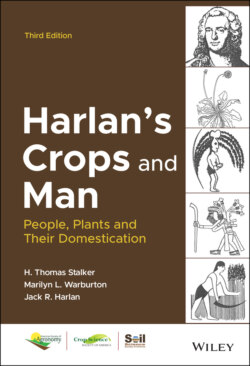Читать книгу Harlan's Crops and Man - H. Thomas Stalker - Страница 25
On Sharing the Bounty
ОглавлениеMuch has been made by some social anthropologists of the more or less egalitarian nature of hunter‐gatherer societies. Game brought in by a hunter is shared by usually strict rules; the hunter himself has little to say about it. Produce gathered by the women and children is normally shared by the whole camp. One may own personal items like digging sticks, bows, arrows, spears, boomerangs, carrying nets, bowls, pots, and so forth, but if someone asks for something, it is very difficult to refuse. There is, in many tribes, a sense of community ownership, but this is likely to vary by degrees of relationship. Nearly all items might be shared by the immediate family or even within an extended family, but sharing becomes diluted with more distant relations. Lee (1988) pointed out that there are strong peer pressures to share freely and to prevent an individual from dominating or even showing pride. Egos are continuously being deflated by bawdy jokes and condescending comments.
The sharing rules may, in fact, cause the fragmentation of large camps. When a game animal is divided into so many shares that each person receives only a tiny scrap of meat, the better hunters are likely to fission off with their immediate families in order not to share with all. People may also resort to hiding personal items in order not to share. The social ideal of sharing freely has appeal, but seems to work best in small intimate groups.
Unharvested resources have a different set of rules. In many areas tribal territories are clearly defined, and even foraging microbands or families may be allotted specified regions, groves, or stands of useful plants. They very rarely harvest on land reserved for other bands. Springs and water holes may be owned by specified groups and the outsider must ask permission even to drink. This is true in both South Africa and Australia. In Australia, land ownership was respected during the burning season. It was considered a serious offense to burn another's foraging range. The time and place of a burn were carefully chosen and serious attempts were made to keep the fires within prescribed bounds (Warner, 1958).
If a pygmy finds a bee tree, he can mark it, and he alone is entitled to harvest the honey. To steal from a marked tree is a serious offense. Among Bushmen the same holds true for ostrich nests as well as bee trees and stealing either one can be punished by death. Some of the hollow trees of Bushmen ranges fill with water and provide an important source of water in a semidesert land. The trees may be individually owned and inheritance may pass from father to son (Marshall, 1960).
Tree marking is also observed in Australia (Gregory, 1886):
A native discovering a Zamia fruit unripe will put his mark on it and no other native will touch this; the original finder of the fruit may rest perfectly certain that when it becomes ripe he has only to go and fetch it for himself.
Property rights are demonstrated by the custom of breaking off the top of the “grass tree” (Xanthorrea), which will then rear large edible grubs. The one who breaks off the top owns the grubs that will be produced later (Grey, 1841).
At least one Aboriginal family is reported to have owned a rock quarry. The head of the family removed slabs of rock, broke them into appropriate pieces, and shaped them crudely as blanks from which ax‐heads could be made. The blanks and spears entered into the long‐distance trading routes established by the Aborigines long before European contact (Coon, 1971).
A number of tribes of the Pacific Northwest kept slaves. These were captured in raids on neighboring tribes, purchased, received as gifts in pot‐latch celebrations, or sometimes generated by voluntary servitude to settle debts. During the extravagant pot‐latches of the 19th century, slaves were sometimes killed as a show of wealth. These rather sedentary tribes had a surplus of goods and commodities which were either distributed or simply destroyed. Such a luxuriant economy does not fit the stereotype of the starving savage (Suttles, 1968).
Also in the same region, houses, not necessarily made of skin or bark, were often individually owned, and some tribes built solid plank houses that were intended to be permanent structures. The Modoc (California–Oregon border) maintained a scheduled round of nomadic movements to exploit various resources at different times of the year. In winter camp, they lived in plank houses that were dismantled and carefully stacked each spring when they moved to summer quarters. The houses were reassembled on their return in late fall or early winter (Ray, 1963).
It would appear that private ownership of resources was well understood by nonagricultural people and probably by preagricultural people as well. The concept of ownership was, and still is, widespread and deeply ingrained in many gathering societies.
